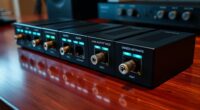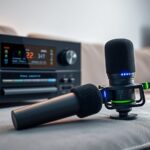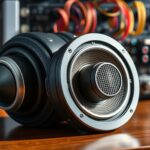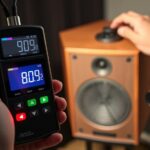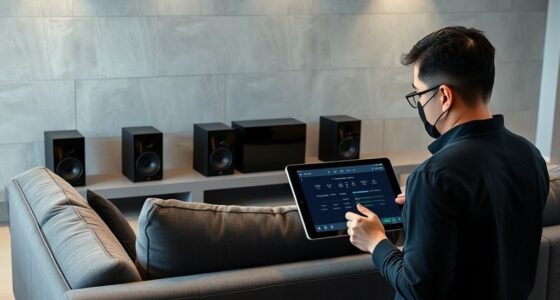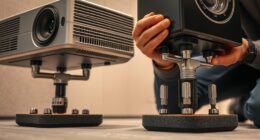Test tones are great for pinpointing specific frequency issues and measuring system response precisely, while pink noise offers a broad, balanced sound spectrum to fine-tune overall sound quality quickly. If you want detailed analysis, test tones are better suited; for general calibration and a natural balance, pink noise works well. Ultimately, combining both methods gives you the best results. Keep exploring to discover how each tool can enhance your audio setup.
Key Takeaways
- Test tones provide precise frequency-specific measurements, ideal for pinpointing specific speaker issues.
- Pink noise offers a broad, balanced spectrum suitable for overall system calibration and sound balancing.
- For detailed frequency response adjustments, test tones are more accurate; for general tuning, pink noise is more efficient.
- Combining both methods yields optimal calibration, leveraging test tones for precision and pink noise for overall balance.
- The choice depends on calibration goals: test tones for accuracy, pink noise for speed and comprehensive assessment.
Understanding the Basics of Calibration Signals

Calibration signals are essential tools used to set and verify audio system accuracy. They help ensure your system reproduces sound accurately across the entire frequency spectrum. These signals provide a consistent reference, making it easier to identify and correct issues with speaker alignment, equalization, or room acoustics. Signal consistency is key, as it guarantees that each calibration test produces reliable results. Whether using test tones or pink noise, understanding how calibration signals work allows you to fine-tune your audio setup effectively. By analyzing how your system responds to these signals, you can make precise adjustments, improve sound quality, and achieve a balanced, professional sound. Mastering calibration signals is fundamental to optimizing your audio environment. High-quality audio depends on accurate calibration signals to reproduce sound faithfully across different frequencies. Recognizing the importance of Signal consistency ensures that your calibration efforts are both reliable and repeatable. Additionally, understanding the difference between test tones and pink noise can help you select the most suitable calibration method for your specific needs.
Advantages and Disadvantages of Test Tones

Test tones are a popular choice for audio calibration because they provide a straightforward way to analyze individual speaker performance. However, they have limitations that can affect calibration accuracy. Since test tones are single frequencies, they don’t replicate real-world sound environments well, which might lead to less accurate overall calibration. Additionally, relying solely on test tones can overlook interactions between multiple speakers and room acoustics. This narrow focus can give a false sense of precision, especially if you’re not considering how your system responds across a broader spectrum. While they’re useful for pinpointing specific issues, test tone limitations mean they shouldn’t be your only calibration tool. For the most accurate results, combine them with other methods to account for the complexities of your listening environment. Using pink noise can help address these limitations by providing a more comprehensive assessment of your audio system’s performance across the entire frequency range. Incorporating broadband signals like pink noise allows for a better understanding of how your system performs in realistic listening conditions, leading to more balanced sound calibration. Moreover, multi-frequency analysis offers insights into the overall sound consistency, which is essential for achieving optimal audio quality. Additionally, utilizing frequency spectrum analysis can help identify specific frequency imbalances that might not be apparent with test tones alone.
Benefits and Drawbacks of Pink Noise

Pink noise offers a balanced and consistent sound profile that makes it highly effective for evaluating and tuning your audio system. Its broad frequency spectrum covers all audible ranges evenly, helping you identify issues across lows, mids, and highs. This uniformity ensures signal consistency, making it easier to detect irregularities or distortions. This makes pink noise particularly suitable for comprehensive audio calibration, as it provides an overall sense of balance in the sound profile. However, pink noise can be less precise for fine-tuning specific frequencies compared to test tones, which are targeted. Additionally, some listeners find pink noise less intuitive because of its steady, masking nature, which can obscure subtle audio details. While it’s excellent for overall calibration, relying solely on pink noise might overlook nuanced adjustments needed for ideal sound quality. Incorporating different audio calibration techniques can enhance your overall sound setup and accuracy. Balancing pink noise with other methods can give you the most all-encompassing results.
Practical Applications and Use Cases

Using pink noise in practical settings allows you to assess and refine your audio system efficiently. It covers a broad frequency spectrum, helping you identify issues across bass, midrange, and treble frequencies. This makes it ideal for calibrating speakers and ensuring even sound distribution. Pink noise also helps verify equipment compatibility by revealing how different components handle various frequencies, highlighting potential mismatches or distortions. You can use pink noise during setup to make quick adjustments, ensuring your system delivers balanced sound. It’s especially useful for tuning home theaters, professional studios, or live sound environments. By listening for inconsistencies or anomalies while pink noise plays, you can fine-tune your gear for *best* performance, saving time and improving overall audio quality. Additionally, understanding speaker tuning principles can further enhance your calibration process. Incorporating audio calibration techniques can help you achieve more precise sound quality and consistency across your system. For optimal results, integrating frequency response analysis can provide a more detailed understanding of your system’s behavior and calibration needs. Moreover, employing sound therapy principles during calibration can help you create a more relaxing listening environment that promotes better focus and enjoyment.
Making the Right Choice for Your Setup

Choosing the right audio calibration method depends on your specific setup and goals. Consider whether you need a broad frequency spectrum coverage or focus on specific ranges. Test tones excel at providing precise signals for measuring signal stability across different frequencies, helping identify weak spots. They are particularly useful when fine-tuning individual components or troubleshooting specific issues within your audio chain. Pink noise offers a more natural, even sound across the spectrum, making it ideal for general calibration. Think about your equipment’s ability to reproduce signals accurately and the importance of a stable calibration process. Additionally, ensure your calibration method aligns with the sound profile you desire for an optimal listening experience, as consistent calibration can significantly enhance sound quality. Using Glycolic Acid in skincare routines can also support skin health, which may influence comfort during long listening sessions. Proper calibration techniques can also help prevent audio distortions, ensuring a clearer and more enjoyable listening environment.
Frequently Asked Questions
Can Calibration Signals Affect Audio Quality Over Time?
Calibration signals can impact your audio quality over time if not used properly. Repeated exposure to certain signals may cause your equipment to drift, affecting the frequency response. However, when used correctly, calibration helps maintain ideal sound, potentially extending your equipment’s longevity. Regular calibration with suitable signals ensures accurate frequency response and prevents unnecessary wear, keeping your audio setup performing well for years to come.
Are There Specific Environments Where Pink Noise Is More Effective?
Think of pink noise as a versatile chameleon, adapting well to various environments. In spaces with high environmental factors like background chatter or machinery, pink noise excels by providing effective noise masking. It’s especially useful in recording studios, control rooms, or open-plan offices where ambient noise can interfere with clarity. Its broad spectrum helps you maintain accurate calibration, ensuring your audio stays precise despite the noise around you.
How Do Calibration Signals Impact Different Audio Equipment Types?
You should consider how calibration signals affect your equipment’s frequency response and compatibility. Different audio gear responds uniquely, so using signals tailored to each device guarantees accurate calibration. For example, test tones work well with speakers, while pink noise helps balance overall sound. By selecting signals suited to your equipment, you optimize performance, achieving consistent, reliable audio quality across your setup.
Is One Calibration Method Universally Better Than the Other?
When it comes to calibration, there’s no one-size-fits-all answer. You might feel one method sounds better, but subjective perception varies. Test tones often provide precise measurement accuracy, making them reliable for detailed calibration, while pink noise can better match how your ears perceive sound in a real environment. Ultimately, choosing depends on your equipment and goals—trust your ears, but back it up with solid measurement.
Can DIY Calibration Methods Match Professional Results?
You wonder if DIY calibration can match professional accuracy. While DIY methods can improve your sound setup considerably, they often lack the precision of professional tools and expertise. By using calibration tools like a microphone and software, you get closer to professional results, but achieving the same level of accuracy requires skill and experience. For peak sound, consider professional calibration, especially for critical listening environments.
Conclusion
Choosing between test tones and pink noise depends on your calibration needs. Did you know that studies show pink noise provides a more consistent frequency response across a room? This makes it ideal for tuning entire spaces. By understanding their strengths and weaknesses, you can make smarter decisions to optimize your setup. Ultimately, selecting the right calibration signal guarantees better sound quality and a more immersive listening experience every time.

